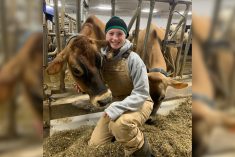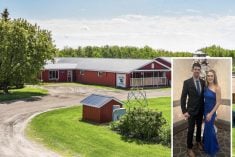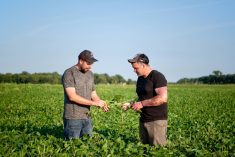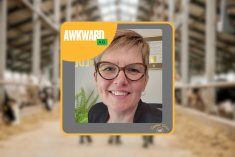By the time you get 70 miles due south of Regina, you know what to expect. The landscape is as open in front of you as it is behind, marked only with occasional crossroads that once in a while still struggle to maintain their names and their status as villages, showing how once, a long time ago, they used to be the home of hopes and ambitions.
It s prosperous farm country, but it sure is one tough place to be a town, and by rights, Ogema and its 360 inhabitants should be struggling as much as any of them.
Read Also

Youth focused on keeping Quebec’s dairy industry strong
In part two of our Making the Future series, Country Guide spoke with Béatrice Neveu from Rawdon, Que. (Read part…
Instead, here in what many would say is the middle of the middle of nowhere, Ogema is a busy, bustling town that has Old World charm and something else that s unexpected new construction.
It hasn t always been that way, and it didn t just happen on its own, so when I ask Mayor Wayne Myron to tell me the story of Ogema s transformation from the beginning, he knows where to start. It s 1989, the year an informal economic development committee of community activists got together to generate ideas, initiate action and find champions for projects in the town.
Other towns had similar committees. Ogema s actually worked. One of the ideas conceived by that group was to bring a hog barn to town. This was a time when hog farming was booming on the Prairies, and Ogema thought they should get a piece of the action.
The hog barn definitely turned this community around 360 degrees, the mayor tells me. Both economically and in mindset.
The South Central Hog Corporation (SCHC) was formed with 10 community members on the board and it borrowed the money required to undertake a series of environmental studies, including a manure management plan and water analysis. The studies were a necessary first step for any serious hog production in the area.
We wanted the business to come to Ogema, but we also wanted to be careful it didn t have any adverse effects on our community either, explains Myron. Next, the group brought a few companies in for meetings and discussions, but in the end, it was Big Sky they decided to go with.
Big Sky purchased the various assessments SCHC had conducted. At first, Big Sky planned a 2,500-sow farrow-to-finish barn, but in the end a 5,000-sow barn was constructed. In fact, it was the first barn of this magnitude in Canada.
The barn brought 55 jobs to Ogema, as well as utilizing over 1.5 million bushels of grain, most of which is supplied by local farmers, Myron says. To say it was a boon to our community is an understatement.
When the barn went up, there was ample local labour to keep it staffed. One thing it made us realize was that our young people really did want to stay at home, Myron says. Once we provided good jobs for them, they didn t have to leave.
Over the next two decades, however, boom times in the oil industry seduced workers with huge earnings that agriculture couldn t match, and the hog barn started to struggle. It was getting tough to find a body for every job in the barn.
Again, there was lots of discussion in the town about how to overcome this hurdle, but it had been
anticipated by the original economic development committee early on.
To sustain their plans for Ogema, immigration was going to be necessary. But how do you start? It was then that Big Sky itself had an opportunity to source employees from the Philippines, which led to setting up relationships with recruiters and developing a channel for Filipino candidates to hear about the Ogema opportunity.
Again, the Ogema community immediately formed a support group that met every Tuesday night at the library, says Myron. The group of volunteers helped the newcomers with everything from housing to clothing to how to get a driver s license.
The immigrants kept coming and now Ogema is home to over 60 Filipino immigrants, including 16 families.
Our community has embraced this change, and I can honestly say our new friends and neighbours love Ogema as well, says Myron. The attitude of the people of Ogema is what turned our community around.
Carol Peterson is the local insurance broker in Ogema, and she was involved in helping the immigrants settle in. Everyone in this small town welcomed the new arrivals with open arms. Retired teachers, seniors and others stepped up to help with whatever they could. Weyburn Community College successfully applied for a grant that helped our local driving instructors work with the newcomers to get their driving licenses, which they needed to get to and from work, says Peterson.
At first I m skeptical. You mean to tell me that no one in the town grumbled about these new people with their different language and different way of doing things?
Try as I might, though, I can t find anyone to complain about the Philippine initiative. But it turns out no one pulled up their welcome mats. No one locked their doors.
We all knew how much we had to lose if they did not come and make Ogema their home, Peterson says. She also gives credit to the immigrants themselves. Most are working toward their landed immigrant and citizenship status as soon as they can.
Besides, says Peterson, It s just so nice to see kids around here again.
Roberto Estember came to Ogema April 25, 2008 from the Philippines. I came to Canada because I am an adventurous person, he tells me. I also was looking for greener pastures for me and my family. Estember s wife Delores and young son joined him a few months later. My wife works also in the pig barn. We are both pork production technicians.
The community helped the Estembers settle in, and Roberto s son is in Grade 2 now and doing well. This past August 2010, Roberto tells me, the family purchased a home& in Ogema.
Estember thinks the adjustment was hardest for his son, considering the weather and the language barrier. He had no English at the time, and he was initially shy and reserved at school. Roberto and his wife on the other hand, learned English themselves in school and were fluent when they came to Canada.
We absolutely have a better life here, says Estember.
Myron tells me that everyone also has a better Ogema. Now we have a new 8,000-square foot, privately-owned grocery store. I have just built an 11,000-square foot Napa AutoParts. Our local massage therapist has opened a new spa that is second to none in Western Canada, with five or six on staff.
He pauses only briefly to catch a breath. We have two financial institutions in our little town. Our school was on the brink of closure two years ago, with a projected population of 53 children. We put together a strategic plan to make more use of the school and the number of children has now grown to 103. And you know how important a school is to a small town? says Myron. There is a daycare now at the school, providing yet more jobs.
It makes my hair stand on end now when I go to a school concert and I see children from playschool to kindergarten to Grade 12, Myron continues. Even our hockey arena was dying. Now we have a nine-and-under, and a six-and-under team. And our senior team is back again, thanks to a lot of expat players that have come home to play. The rink is rejuvenated.
Myron is positively carried away as he describes how one success leads to another, and then another. When the immigrant families first arrived they found rental units to live in. It wasn t long and they were buying their own homes for the first time. Now Ogema has a housing crisis!, Myron says.
It hasn t all been smooth sailing. Ogema still suffers from a lack of infrastructure dollars, but this is a hazard of growth, says the mayor. In other words, it s a good problem to have.
It has also taught the community that it s possible to control change, so when I hear the story of how Ogema saved its grain elevator, it all fits together.
When Saskatchewan Pool announced it would be closing the elevator and was open to having someone purchase it, 29 farmers got together at a meeting and left 29 cheques behind, enough to finalize the purchase in three months. Now, Big Sky uses the annex at Ogema Elevator Ltd. to store grain, and farmers load producer cars with the rest of the elevator, bringing yet more employment to town.
Local farmers purchased and now run the local CP rail line that was to be abandoned. Anyone who knows small towns knows that if they lose their rail line, it s another few nails in the coffin lid.
Saving the rail line has allowed local famers to use the elevator to load producer cars, and most recently, the Ogema Heritage Railway Association has purchased a 1944 diesel locomotive and a 1922 passenger car from Gettysburg, Pennslyvania.
They hope to have it operational for tourists for the 100th anniversary of Ogema next year. Not only is the first venture of this kind in Saskatchewan, it will give much needed summer employment for students.
We have a great community, says Myron. It s grown from about 292 to over 360 now, and our strategic plan will have us double this again in 10 years.
Others are taking note. Ogema for instance captured a silver award in the Most Livable Community category in the 2008 LivCom Awards in Dongguan, China against 55 other global towns and cities, and a gold for heritage management.
Really, Ogema is a token of what s going on in Saskatchewan right now, says the mayor. This is a great place to live. CG
Andrea Hilderman has worked in the grain industry for 20+ years. She writes from Winnipeg, Man. She has a Master s degree in Weed Science and is a member of the Manitoba Institute of Agrologists.
———
We all knew how much we had to lose if they did not come and make Ogema their home. Carol Peterson














